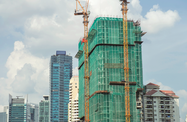The central bank of Malaysia has outlined a plan to strengthen the residential property market and improve access to affordable housing, as persistent oversupply and high prices continue to weigh on sector growth.

In mid-February Bank Negara Malaysia (BNM) set out its strategy to help bolster the real estate market, highlighting a range of potential administrative, educational and policy solutions.
Central to the strategy is the creation of a single entity to manage and process affordable housing initiatives between state agencies and private players; at present, there are more than 20 bodies that carry out housing policy and support. Streamlining administrative processes would end the current duplication of services, reduce costs and help the government deliver an additional 1m units between 2013 and 2018, according to BNM.
The bank has also placed an emphasis on cutting construction costs, suggesting employee upskilling, advanced construction practices and standardised housing codes as possible measures to achieve this.
Furthermore, the bank recommended steps be taken to improve financial literacy among Malaysians to allow them to better manage their finances, and suggested improvements be made to the legal framework of the rental market. This could help stimulate greater activity in a country with a traditionally small rental market.
Oversupply combines with affordability issues
The recommendations come amid decade-high levels of oversupply in the residential segment.
There were 146,000 unsold residential units as of mid-2017, up from the 131,000 recorded at the end of the first quarter, according to BNM data.
Of the unsold units, 82% were priced above RM250,000 ($63,900). Although the government considers the maximum price for affordable housing to be RM282,000 ($72,100), the actual median sale price of units during the period was RM313,000 ($80,000), out of reach for many people in a country where the monthly median household income is RM5230 ($1340).
The mismatch between prices and wages has been cited as a major factor affecting housing affordability in recent years. Central bank data shows housing prices rose by 9.8% between 2007 and 2016, while incomes increased by 8.3%. The discrepancy was more acute in 2012-14, when prices grew by 26.4%, against a 12.4% increase in wages.
In mid-February Sulaiman Akhmady Mohd Saheh, the research director of property consultancy Rahim & Co International, told local media that on average, a standard terrace house would cost Malaysians 5.3 times their annual household income.
The situation is more dramatic in some parts of the country; Rahim & Co’s “Property Market Review 2017/18” estimates that an average home would cost 8.4 times the annual median household income in Sabah, and 6.9 times that in both Kuala Lumpur and Penang.
Construction, land costs keeping prices high
Despite excess supply in the market, there has been little downward movement in asking prices.
Apart from a 10% contraction in high-end residential prices over the past 18-24 months, the rest of the market has remained largely steady.
A major reason for this, according to Rahim & Co, is the already tight margins faced by developers, who are restricted in their ability to cut prices due to high building costs.
Construction costs account for around 80% of property prices, according to the Real Estate and Housing Developers’ Association Malaysia, with bureaucratic processes, materials and equipment seen as key contributors.
Some industry stakeholders have highlighted the high cost of land as another major factor, leading to calls for both federal and state governments to release cheaper land for the purpose of affordable housing.
Transactions values, wage rises, point to industry rebound
Despite these challenges, the market is showing some signs of increased resilience, with the downturn in transaction volume flattening out last year.
While the number of property transactions to the end of September fell by 4.3% year-on-year (y-o-y), according to the Valuation and Property Services Department (JPPH), the decline compares favourably to the 11.9% drop posted over the same period in 2016.
Although year-end figures have yet to be finalised, the JPPH estimated that transactions would total around 300,000, close to the 320,000 of the preceding year.
Another encouraging sign came from transaction values, which rose 7% y-o-y to the end of the third quarter, the first recorded increase since 2015.
Any further rebound could be supported by an economic turnaround; GDP is expected to expand by 5.3% this year, according to the IMF, potentially firming up consumer and business confidence.
Combined with wage growth in 2018, which consultants Korn Ferry predict will rise by 3.2%, economic growth could translate into increased appetite for property, reinforcing expectations of a modest recovery later this year.


